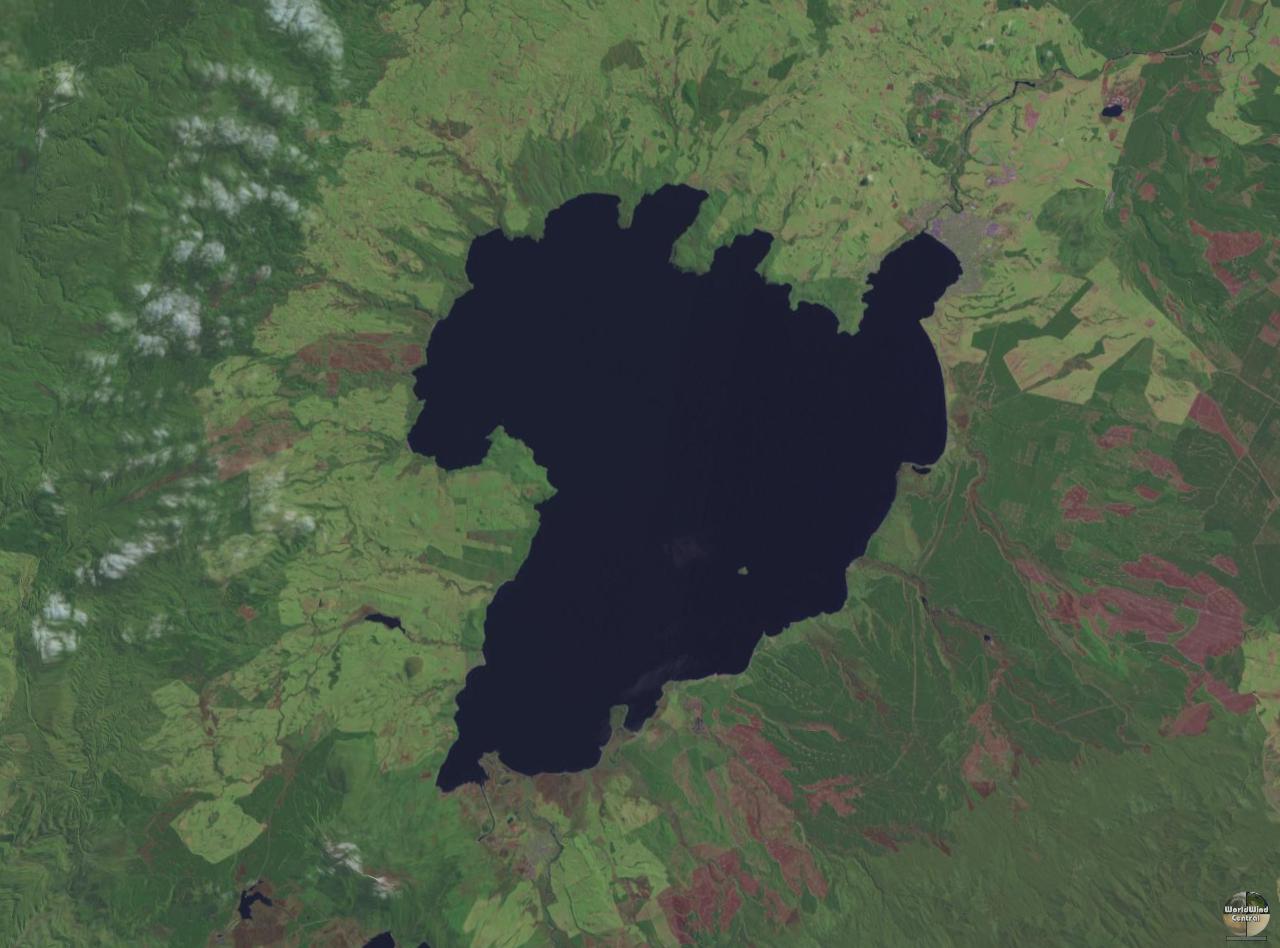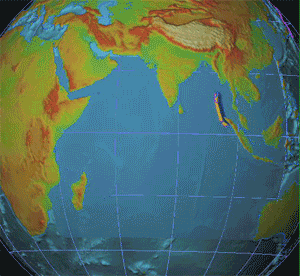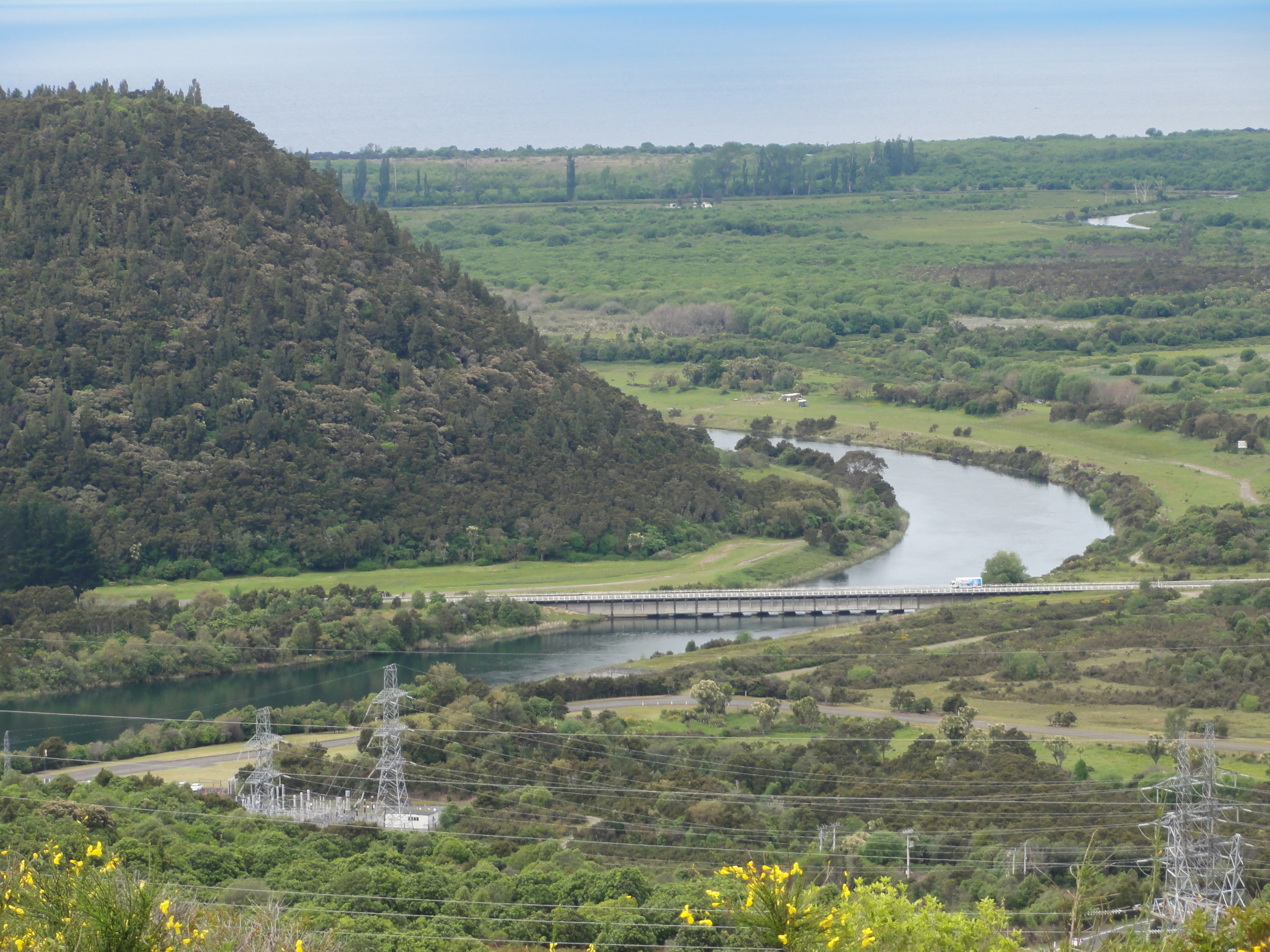|
National Park Fault
The National Park Fault is the western Taupō rift-bounding NNE-striking normal fault complex of the Tongariro Graben, a seismically active area of the central North Island of New Zealand south of Lake Taupō that contains Mount Tongariro. Geography It is located near the western side of the Tongariro National Park. The northern surface traces of the fault zone are found on the slopes of Kuharua, a high rhyolitic volcano and extend southwards around Lake Otamangakau and Lake Te Whaiau, lakes developed as part of the Tongariro Power Scheme. The western traces here are just to the west of the mutual dams of these lakes on the eastern slopes of the Maungakatote andesitic volcano and then peter out. The definitive fault surface trace commences in the hills near the headwaters of the Okupata stream just to the west of State Highway 47 and extends south close on to National Park township just to the south of the Railway Station. Geology The southern end of the fault joins the ... [...More Info...] [...Related Items...] OR: [Wikipedia] [Google] [Baidu] |
National Park, New Zealand
National Park (officially Waimarino) is a small town on the North Island Volcanic Plateau, North Island Central Plateau in New Zealand. Formerly known as National Park Village, it is the highest urban township in New Zealand, at 825 metres. The village has great views of Mount Tongariro, Mount Ngauruhoe (Mount Doom in the The Lord of the Rings (film series), ''Lord of the Rings'' film trilogy), and Mount Ruapehu. Toponymy Originally the town was known as Waimarino (calm waters). In 1926, the New Zealand Railways renamed the railway station as National Park. This was to avoid confusion with other Waimarino entities, and also the name had come into common usage from its location close to Tongariro National Park. This change has since been confusing, as there are now many National Parks in New Zealand. After a three month nation-wide consultation culminated in 2,582 submissions including from a number of local iwi, residents, the applicant iwi Te Korowai o Wainuiārua. ... [...More Info...] [...Related Items...] OR: [Wikipedia] [Google] [Baidu] |
Lake Taupō
Lake Taupō (also spelled Taupo; or ) is a large crater lake in New Zealand's North Island, located in the caldera of Taupō Volcano. The lake is the namesake of the town of Taupō, which sits on a bay in the lake's northeastern shore. With a surface area of , it is the largest lake by surface area in New Zealand, and the second largest freshwater lake by surface area in geopolitical Oceania after Lake Murray in Papua New Guinea. Motutaiko Island lies in the southeastern area of the lake. Geography Lake Taupō has a perimeter of approximately and a maximum depth of . It is drained by the Waikato River (New Zealand's longest river), and its main tributaries are the Waitahanui River, the Tongariro River, and the Tauranga Taupō River. It is a noted trout fishery with stocks of introduced brown and rainbow trout. The level of the lake is controlled by Mercury Energy, the owner of the eight hydroelectric dams on the Waikato River downstream of Lake Taupō, using gates b ... [...More Info...] [...Related Items...] OR: [Wikipedia] [Google] [Baidu] |
Seismic Faults Of New Zealand
Seismology (; from Ancient Greek σεισμός (''seismós'') meaning "earthquake" and -λογία (''-logía'') meaning "study of") is the scientific study of earthquakes (or generally, quakes) and the generation and propagation of elastic waves through planetary bodies. It also includes studies of the environmental effects of earthquakes such as tsunamis; other seismic sources such as volcanoes, plate tectonics, glaciers, rivers, oceanic microseisms, and the atmosphere; and artificial processes such as explosions. Paleoseismology is a related field that uses geology to infer information regarding past earthquakes. A recording of Earth's motion as a function of time, created by a seismograph is called a seismogram. A seismologist is a scientist who works in basic or applied seismology. History Scholarly interest in earthquakes can be traced back to antiquity. Early speculations on the natural causes of earthquakes were included in the writings of Thales of Miletus (), Anax ... [...More Info...] [...Related Items...] OR: [Wikipedia] [Google] [Baidu] |
Tephra
Tephra is fragmental material produced by a Volcano, volcanic eruption regardless of composition, fragment size, or emplacement mechanism. Volcanologists also refer to airborne fragments as pyroclasts. Once clasts have fallen to the ground, they remain as tephra unless hot enough to fuse into pyroclastic rock or tuff. When a volcano explodes, it releases a variety of tephra including ash, cinders, and blocks. These layers settle on the land and, over time, sedimentation occurs incorporating these tephra layers into the geologic record. Tephrochronology is a geochronological technique that uses discrete layers of tephra—volcanic ash from a single eruption—to create a chronological framework in which Paleoecology, paleoenvironmental or Archaeology, archaeological records can be placed. Often, when a volcano explodes, biological organisms are killed and their remains are buried within the tephra layer. These fossils are later dated by scientists to determine the age of the ... [...More Info...] [...Related Items...] OR: [Wikipedia] [Google] [Baidu] |
Raurimu Fault
The Raurimu Fault is the western Taupō rift-bounding north–south striking normal fault complex of the Ruapehu Graben, a seismically active area of the central North Island of New Zealand to the west of Mount Ruapehu. Geography It is located near the western side of the Tongariro National Park, mainly in the Erua Forest, where it is along the western Waimarino Stream valley. The northern surface traces of the fault commence near the Raurimu Spiral and the most southern surface is over to the south just to the east of the township of Raetihi. Geology The northern end of the fault is intersected at the township of National Park by the National Park Fault which is the more northern Taupō Rift western wall fault. Lahar deposits of late Pleistocene (20,000 to 60,000 years ago) are offset by up to . At its southern end the fault alignment is crossed by the east west Ohakune Fault which creates just to the east of Ohakune a quite complex normal fault structure. The north sou ... [...More Info...] [...Related Items...] OR: [Wikipedia] [Google] [Baidu] |
State Highway 47 (New Zealand)
State Highway 47 (SH 47) is a New Zealand state highway in the central North Island. It provides a link from at National Park to at Tokaanu just west of Tūrangi. For its entire length, SH 47 is a single carriageway road with one lane in each direction and at-grade intersections and property accesses. There are no significant towns on the route. The New Zealand Transport Agency classifies the section of SH 47 as an arterial route south of the intersection and a primary collector route north of the SH 46 intersection. Route SH 47 travels in a general northeast direction from National Park across the Tongariro volcanic plateau. 9 km from its starting point it reaches the junction of which connects to Whakapapa Village and the ski area on the northern slopes of Mount Ruapehu. A further 14 km north-west is the junction with Lake Rotoaira Road (SH 46), an alternative route to and the Desert Road. SH 47 continues for a further 25 km over the Te Ponanga Sadd ... [...More Info...] [...Related Items...] OR: [Wikipedia] [Google] [Baidu] |
Andesite
Andesite () is a volcanic rock of intermediate composition. In a general sense, it is the intermediate type between silica-poor basalt and silica-rich rhyolite. It is fine-grained (aphanitic) to porphyritic in texture, and is composed predominantly of sodium-rich plagioclase plus pyroxene or hornblende. Andesite is the extrusive equivalent of plutonic diorite. Characteristic of subduction zones, andesite represents the dominant rock type in island arcs. The average composition of the continental crust is andesitic. Along with basalts, andesites are a component of the Geology of Mars, Martian crust. The name ''andesite'' is derived from the Andes mountain range, where this rock type is found in abundance. It was first applied by Christian Leopold von Buch in 1826. Description Andesite is an aphanitic (fine-grained) to porphyritic (coarse-grained) igneous rock that is intermediate in its content of silica and low in alkali metals. It has less than 20% quartz and 10% feldspa ... [...More Info...] [...Related Items...] OR: [Wikipedia] [Google] [Baidu] |
Tongariro Power Scheme
The Tongariro Power Scheme is a 360 megawatt, MW hydroelectricity scheme in the central North Island of New Zealand. The scheme diverts water from tributaries of the Rangitikei River, Rangitikei, Whangaehu River, Whangaehu, Whanganui, and Tongariro River, Tongariro rivers. These rivers drain a area including Mount Ruapehu, Ruapehu, Ngauruhoe, Tongariro and the western Kaimanawa Ranges. The water diverted from these rivers is sent through canals and tunnels to generate electricity at three hydro power stations, Rangipo (120 MW), Tokaanu (240 MW) and Mangaio (2 MW). The water is then discharged into Lake Taupō where it adds to the water storage in the lake and enables additional electricity generation in the succession of power stations down the Waikato River. The scheme generates approximately 1350 GWh of electricity annually, and contributes 4 percent of New Zealand's electricity generation. It is currently operated by electricity generation company Genesis Energ ... [...More Info...] [...Related Items...] OR: [Wikipedia] [Google] [Baidu] |
Rhyolite
Rhyolite ( ) is the most silica-rich of volcanic rocks. It is generally glassy or fine-grained (aphanitic) in texture (geology), texture, but may be porphyritic, containing larger mineral crystals (phenocrysts) in an otherwise fine-grained matrix (geology), groundmass. The mineral assemblage is predominantly quartz, sanidine, and plagioclase. It is the extrusive equivalent of granite. Its high silica content makes rhyolitic magma extremely viscosity, viscous. This favors explosive eruptions over effusive eruptions, so this type of magma is more often erupted as pyroclastic rock than as lava flows. Rhyolitic ash-flow tuffs are among the most voluminous of continental igneous rock formations. Rhyolitic tuff has been used extensively for construction. Obsidian, which is rhyolitic volcanic glass, has been used for tools from prehistoric times to the present day because it can be shaped to an extremely sharp edge. Rhyolitic pumice finds use as an abrasive, in concrete, and as a soil ... [...More Info...] [...Related Items...] OR: [Wikipedia] [Google] [Baidu] |
Tongariro National Park
Tongariro National Park (; ), located in the central North Island, is the oldest national park in New Zealand and the sixth national park established in the world.Department of Conservation"Tongariro National Park: Features", retrieved 21 April 2013 It has been recognised by UNESCO as a World Heritage Site for its mixed cultural landscape, cultural and natural heritage, natural values. The active Volcano, volcanic mountains Mount Ruapehu, Ruapehu, Mount Ngauruhoe, Ngauruhoe, and Mount Tongariro, Tongariro are located in the centre of the park. Three ski fields operate from the slopes of Mount Ruapehu, and the park is also a popular recreation area for hiking, fishing, hunting and other outdoor pursuits. Tongariro National Park is home to the famed Tongariro Alpine Crossing, widely regarded as one of the world's best one-day hikes. The natural environment of the park ranges from temperate rainforest to beech forest, tussock shrubland and alpine ecosystems. A variety of endemic ... [...More Info...] [...Related Items...] OR: [Wikipedia] [Google] [Baidu] |
Mount Tongariro
Mount Tongariro (; ) is a compound volcano in the Taupō Volcanic Zone of the North Island of New Zealand. It is located to the southwest of Lake Taupō, and is the northernmost of the three active volcanoes that dominate the landscape of the central North Island. Geology Mount Tongariro is part of the Tongariro volcanic centre, which consists of four massifs made of andesite: Tongariro, Kakaramea-Tihia Massif, Pihanga, and Ruapehu at the southern end of the North Island Volcanic Plateau. The andesitic eruptions formed Tongariro, a steep stratovolcano, reaching a height of . Tongariro is composed of layers of both lava and tephra and the eruptions that built the current stratovolcano commenced about 275,000 years ago. Tongariro consists of at least 12 cones. Ngauruhoe, while often regarded as a separate mountain, is geologically a cone of Tongariro. It is also the most active vent, having erupted more than 70 times since 1839, the last episode in 1973 to 1975. Activ ... [...More Info...] [...Related Items...] OR: [Wikipedia] [Google] [Baidu] |
North Island
The North Island ( , 'the fish of Māui', historically New Ulster) is one of the two main islands of New Zealand, islands of New Zealand, separated from the larger but less populous South Island by Cook Strait. With an area of , it is the List of islands by area, world's 14th-largest island, constituting 43% of New Zealand's land area. It has a population of which is % of New Zealand's residents, making it the most populous island in Polynesia and the List of islands by population, 28th-most-populous island in the world. Twelve main urban areas (half of them officially cities) are in the North Island. From north to south, they are Whangārei, Auckland, Hamilton, New Zealand, Hamilton, Tauranga, Rotorua, Gisborne, New Zealand, Gisborne, New Plymouth, Napier, New Zealand, Napier, Hastings, New Zealand, Hastings, Whanganui, Palmerston North, and New Zealand's capital city Wellington, which is located at the south-west tip of the island. Naming and usage The island has been known ... [...More Info...] [...Related Items...] OR: [Wikipedia] [Google] [Baidu] |









